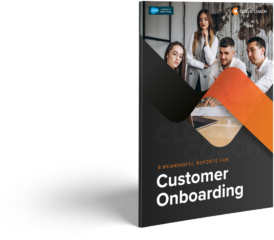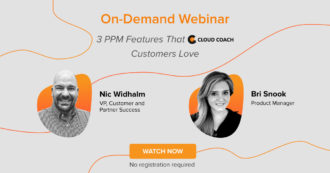 eBooks
eBooks
- Solutions
- Customer Onboarding
- Customer Success
- Professional Services Automation
- Project Management
- Project Portfolio Management
-
Solutions
-
Features
- Why Cloud Coach
- Customers
-
Resources

Measuring customer success metrics and data is integral to organizations hoping to understand and measure their success and progress to grow and expand. A crucial measure successful businesses often prioritize is annualized contractual value, called ACV. Companies built on Salesforce’s cloud-based platform must thoroughly understand critical customer success metrics to identify new opportunities and strengthen customer relationship management strategies.
A company’s ACV forecast helps determine new add-on opportunities to better understand how much ongoing customer contracts are worth based on an annual value. ACV allows businesses to measure the total dollar value of various customer accounts, providing a cohesive and accurate revenue forecast.
ACV is measured by taking the total annual revenue and dividing it by a company’s number of paying customers. Knowing how to calculate ACV in Salesforce is possible using the following formula:
Total contract value / total years in contract = Annual contract value
While the formula might seem straightforward, numerous customer success measures in Salesforce are necessary for organizations to understand and master customer onboarding while tracking and measuring current success metrics and data. By knowing how to utilize Salesforce to achieve this goal, organizations can understand customers on a deeper level and harness the power of Salesforce to maximize organizational efficiency.
Organizations seeking strategies to master success and deliver a quality customer experience can seek solutions like Cloud Coach to onboard customers and understand Salesforce customer success metrics on a deeper level. Cloud Coach is essential to leverage your applications through a professional service solution built on Salesforce.
Cloud Coach ensures flexible and accessible solutions to deliver a quality experience and aid your business by improving your company’s customer success metrics. Because many organizations overlook the numerous ways they can harness the power of Salesforce to boost customer success, vendors like Cloud Coach are essential to ensure that your business makes a profit.
Salesforce Customer Success Platform
Implementing Salesforce as a customer success platform is essential for many organizations looking to identify crucial customer success metrics. Platforms like Clouch Coach are essential to onboarding and ensure everything runs smoothly to maximize customer success in your business. Before taking advantage of the Salesforce customer success platform, organizations must understand some crucial factors contributing to a successful strategy and implementation of new customer onboarding tactics.
Customer satisfaction (CSAT) in Salesforce is possible through Cloud Coach’s interface backed by the Salesforce platform to deliver consistent projects and meet customer expectations. A comprehensive Salesforce CSAT report is collected through a customer satisfaction survey. Answers are given on a scale from 1-5, with 1 representing a very dissatisfied experience and 5 representing a completely satisfied experience. The responses collected from this survey are collected and averaged, resulting in a definitive CSAT score.
A Salesforce CSAT report is vital to identify growth opportunities within a business and delivering a consistent customer experience. Additionally, it’s essential to understand the various acronyms used when discussing the Salesforce customer success platform, such as ACV vs. AOV. Salesforce defines ACV as Annual Contract Value, while AOV represents a customer’s Annual Order Value.
The AOV identifies the number of orders a customer places with your company over a specified period and is another crucial measure of customer satisfaction and success. While Salesforce provides metrics for understanding your success rates, companies require onboarding solutions to maximize CSAT and align with customer needs. Driving CSAT scores with onboarding help from Cloud Coach is possible through some of the following capabilities:
- Driving better billable utilization
- Tracking timelines and deliverables
- Skills-based resourcing
- Aligning with client goals
- Tracking real-time metrics with cohesive reports
- Maintaining control of onboarding projects
- Collecting project documentation in a single view
- Identifying risks and current issues
- Transforming opportunities into onboarding projects
ADDITIONAL LINKS
Salesforce Customer Success Strategy
Identifying what makes for a successful customer experience requires a comprehensive Salesforce customer success strategy to understand the most effective onboarding solutions for growing your business. Developing robust Salesforce customer success plans is possible when one understands what makes for a good customer experience, particularly when tracking customer onboarding as a project in Salesforce.
Building a successful strategy to maximize the customer experience is more likely when following some of the tips outlined below:
- Build customer success metrics to measure the effectiveness of your customer onboarding strategies and solutions, including ACV, AOV, and customer adoption metrics.
- Identify your current customer needs and expectations by considering similarities across customer segments and feedback to better understand expectations.
- Invest in technology and project planning solutions like Cloud Coach.
- Define the scope of individual roles in your customer success team.
- Always put the customer at the center of your business when tracking customer onboarding to foster a culture of customer success and satisfaction.
Creating a pleasant customer experience requires a deeper understanding of the success plans when tracking customer onboarding as a project in Salesforce. Salesforce provides three specific Salesforce customer success plans as described below:
- Standard success plan: this Salesforce customer success strategy provides self-guided resources to upskill teams and prepare them for onboarding projects.
- Premier success plan: the Premier success plan fast tracks customer success strategies with unique guidance tailored to individual business outcomes.
- Signature success plan: The final option allows businesses to maximize their ROI with personalized, expert solutions tailored to their needs.
When devising a Salesforce customer success strategy to track customer onboarding, the correct success plan depends on your needs. Utilizing Salesforce when tracking and measuring customer success metrics and data is adequate when used alongside solutions like Cloud Coach to deliver successful projects for customer success and onboarding.
Salesforce KPI Dashboard
Tracking your key performance indicators (KPIs) through Salesforce is essential for collecting and analyzing accurate customer success metrics. A Salesforce KPI dashboard provides a visual overview and summary of crucial KPIs to better understand your company’s sales performance and how it relates to your overall customer satisfaction score. A sales KPI dashboard includes careful analysis and insights into some of the following performance indicators:
- Follow-up contact rates
- Sales activities
- Average order value (AOV)
- Sales cycle length
- Lead response time
- Number of customer deals
These metrics provide insights into your company’s overall sales performance to identify areas of improvement to focus on in the upcoming year. Having thorough sales KPIs examples is more accessible when your KPIs are laid out across a dashboard.
Setting up a sales KPI dashboard is essential to understand your customer and meeting customer expectations that have previously gone under the radar. A standard set-up process for a sales KPI dashboard typically includes the following crucial factors:
- Creating reports that will supply the necessary data
- Dashboard Security
Creating your actual dashboard can be done through the following steps:
- Identify the goal of your Salesforce KPI dashboard.
- Determine what information you want users to see when they view the dashboard.
- Determine whether users have the appropriate permissions to view data in your dashboard.
- Create underlying reports for your dashboard.
- Access the dashboards tab in Salesforce.
- Drag the source report into the dashboard editor tab.
- Drag the component into the dashboard editor.
- Implement a straightforward naming strategy for the header and titles in your dashboard to help users identify the information they’re seeing and how it relates to customer success metrics.
- Save your Salesforce KPI dashboard and distribute it amongst your team members by clicking on ‘Save’ at the top left of the page, then entering the name of your dashboard and selecting a location to store the dashboard. Your folder settings determine who can access and use the KPI dashboard.
Salesforce Performance Metrics
Your Salesforce performance metrics contribute significantly to understanding customer success and your organization’s overall performance. The Salesforce customer success metrics survey provides vital insights into customer success and how organizations perform with crucial business metrics. Sales performance metrics are some of the most critical customer success and satisfaction indicators. They make them vital to understand your current performance and whether your company delivers as promised to its customers.
Another critical element of customer success forecasting strategies is a comprehensive pipeline forecasting strategy. Salesforce provides solutions for sales pipeline forecasting to predict your future pipeline based on your current and previous sales performance and industry trends.
Salesforce prioritizes two main goals when practicing pipeline forecasting to tie in customer success and project metrics into your overall performance metrics: to develop a healthy and sustainable sales pipeline and to win more deals with customers. Pipeline forecasting health is measured through the following dimensions:
- Size
- Shape
- Contents
Pipeline forecasting implements three core assumptions:
- Future deals will reach a specific size.
- The likelihood of a business winning a deal.
- The expected closing date for future deals.
Pipeline forecasting is integral to predicting your customers’ future performance and behaviors. Within accurate pipeline forecasting, businesses struggle to understand and master customer onboarding. Forecasting sets realistic expectations for customer success and satisfaction. Platforms like Cloud Coach provide seamless customer onboarding for organizations operating with Salesforce services.
Salesforce is a vital resource for organizations looking to track and measure customer success metrics and data to better meet the expectations of current and future customers. A successful customer onboarding process benefits from solutions built on Salesforce, such as Cloud Coach, which helps companies deliver successful onboarding projects. Cloud Coach delivers solutions for customer success, onboarding, professional service, software implementation, and project management teams to provide accessible and consistent results.
Helpful Resources
See Cloud Coach In Action
We’d be happy to provide a bespoke 1:1 demo on how Cloud Coach can benefit for your business.























